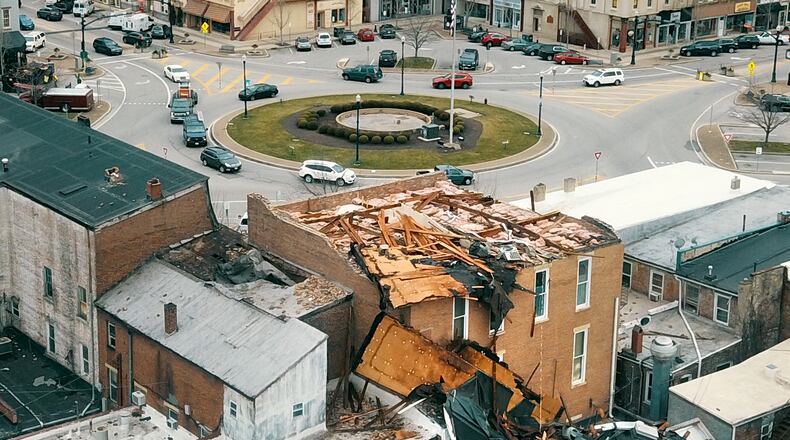“Our technology — not only its resolution, but also how frequently it updates — enables us to see things that maybe 10 years ago would not have been the case,” said Kristen Cassady, a National Weather Service meteorologist based in Wilmington.
The state recorded 193 tornadoes between 2000 and 2009; the number jumped to 300 the following decade ending in 2019, according to the National Oceanic and Atmospheric Administration’s Storm Event Database.
But some weaker tornadoes might have simply gone undetected in previous decades, Cassady said.
“A lot of (the increase) is on the lower end, a lot of EF0s and EF1s, which certainly can do quite a bit of damage. Of course, once you go up that rating scale, the damage threat tends to increase rather substantially and we’re not necessarily seeing that those are increasing,” she said.
Some of the more recent technology includes dual-polarimetric radar that transmits and receives pulses in both a horizontal and vertical orientation. As a result, the returning frequencies provide measurements of the horizontal and vertical dimensions of targets, supplying forecasters with better estimates of the size, shape and variety of targets within the atmosphere, according to the National Weather Service.
Dual-polarimetric radar lets meteorologists differentiate between clouds, snowflakes, rain, hail stones — and debris pulled miles into the sky, said Andy Hatzos, another meteorologist in the Wilmington office.
“We know that if debris is lofted high into the atmosphere, that it’s going to be shaped in a very chaotic way, because we’re talking about pieces of trees, pieces of grass, leaves, pieces of structures,” he said.
Cassady said another possible explanation for the decade over decade increase is the number of people with smartphones who quickly gather photos during storms and make social media posts, which get forwarded to the National Weather Service.
“If you rewind the clock 10 years ago, if there was major damage to a structure, we would have heard about it. But if it was some trees down and maybe some shingles off a structure — more on the lower end (of the EF scale) — that’s not necessarily something we would have heard about,” she said.
During 2019, Ohio 58 recorded tornadoes. The most powerful of the Memorial Day tornadoes, an EF4 that sliced across Montgomery County, accounted for 166 of the 180 tornado injuries that year. One fatality and six injuries were recorded in Mercer County by an EF3 tornado during the same outbreak, according to federal data.
The cumulative paths of Ohio’s Memorial Day 2019 tornadoes stretched about 100 miles and stayed on the ground a combined three hours, Hatzos said.
Last year, 24 tornadoes were reported in Ohio, none stronger than EF1 causing no injuries or deaths. Three EF0 tornadoes touched down in Miami County during 2020, one in January caused significant roof damage to buildings in downtown Troy.
No tornadoes have been reported this year and just eight severe thunderstorm warnings have been issued within the 52 counties the Wilmington office covers in southwest and central Ohio, southeast Indiana and northern Kentucky.
Ohio is inching closer to another record: the latest date for a calendar year’s first confirmed tornado, which came June 12, 2013, according to Hatzos.
“This is very quiet here so far … No tornadoes. Not at all. Nothing even close,” he said. “This will change. It will absolutely change.”
Tornadoes can range in intensity. Wind speeds are measured on the Enhanced Fujita scale, which was implemented in February of 2007:
EF-0
- Estimated wind speeds: 65 to 85 mph
- Observations: Light damage overall. Winds will pull siding or gutters off homes, broken tree branches and shallow-rooted trees pushed over.
EF-1
- Estimated wind speeds: 86 to 110 mph
- Observations: Moderate damage. Roofs stripped of shingles. Mobile homes overturned or damaged. Broken glass to windows or other glass.
EF-2
- Estimated wind speeds: 111 to 135
- Observations: Considerable damage. Roofs torn off well-constructed homes. Mobile homes completely destroyed. Large trees snapped or uprooted. Cars lifted off ground.
EF-3
- Estimated wind speeds: 136 to 165 mph
- Observations: Severe damage. Well-constructed homes destroyed. Severe damage to large buildings like shopping malls. Heavy cars lifted off the ground and thrown. Trains overturned.
EF-4
- Estimated wind speeds: 166 to 200 mph
- Observations: Devastating damage. Whole frames of well-constructed homes completely leveled. Cars thrown and small missiles generated
EF-5
- Estimated wind speeds: Over 200 mph
- Observations: Incredible damage. Strong frame houses leveled off foundations and swept away. Car-sized missiles fly through the air over 100 yards. High-rise buildings have significant deformation.
Sources: National Weather Service, The Weather Channel
About the Author

